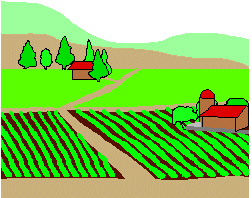| | Barley is the primary source of energy in typical feedlot cattle diets. Unless barley is adequately processed by grinding or rolling, its digestibility will be substantially reduced. This is because the whole barley kernel is not extensively damaged during eating and its fibrous hull limits access to its starchy core by both microbes in the rumen and digestive enzymes in the lower digestive tract. Conversely, barley which is finely processed is rapidly digested in the rumen - an advantage in terms of maximizing its digestibility but a disadvantage due to higher risk of rumen acidosis. What is the optimum degree of processing for barley in feedlot cattle diets?

Processing Index (PI)
Words like 'coarse' and 'fine' are too vague to define a particular degree of processing. So, we developed the concept of Processing Index (PI) to describe degree of processing for a sample of grain.
As barley is rolled more finely, its bushel weight decreases. Processing index is the bushel weight of the barley after processing expressed as a percentage of the bushel weight before processing. For example, if a sample of barley had a bushel weight of 50 pounds before rolling and 35 pounds after rolling, its PI would be 70% (35/50 x 100%). We measured PI of processed grain used in nine southern Alberta feedlots and found that the average PI ranged from 72 to 91%.
Optimum PI for Feedlot Cattle
Growth rate
Two studies were conducted at the at the Lethbridge Research Centre to determine optimum PI for feedlot cattle. In the first study, Hereford calves (250 kg) were finished on all-concentrate diets containing steam-rolled barley. In the next study, crossbred calves (350 kg) were finished on a diet of temper-rolled barley and 8% barley silage (on a dry matter basis). Both studies showed that average daily gain was maximized when barley PI was about 81-82%, despite the fact the that diets varied substantially in proportion of forage (Table 1).
Feed to gain ratio
Feed to gain ratio was not affected by PI of grain, except in the case of whole grain (PI=100%). Those cattle had to eat more feed per kilogram of gain because the digestibility of whole barley was 16 percentage points lower than the digestibility of barley processed to a PI of 81%. Those results prompted us to look at how PI of barley affects its digestibility.
Table 1. Effects of Processing Index (PI) on average daily gain (ADG) and feed to gain ratio of feedlot cattle.
Study 1 | Study 2 |
| PI of barley | ADG (kg/d) | Feed:gain | PI of barley | ADG (kg/d) | Feed:gain |
74 | 1.49 | 6.3 | 69 | 1.49 | 6.2 |
82 | 1.62 | 6.2 | 75 | 1.48 | 6.9 |
92 | 1.53 | 6.7 | 81 | 1.65 | 6.5 |
100 | 1.38 | 7.7 | 86 | 1.5 | 7.8 |
Digestibility
Calves were fed a diet of temper-rolled barley and 10% barley silage (on a dry matter basis) and digestibility of starch in the rumen, in the intestines, and in the total gastrointestinal tract was measured. As expected, decreasing the degree of rolling decreased the rate and extent of barley grain digestion in the rumen. For coarsely rolled grain (PI=86%) only 80% of the starch was digested in the rumen compared with 86% of starch for grain that was finely rolled (PI=69%). However, it is apparent that intestinal digestion can partially compensate for decreased ruminal digestion. When less starch from grain was digested in the rumen, more was digested in the intestines. For grain with a PI of 81% or lower, the intestinal digestion fully compensated for any decrease in ruminal digestion, so that total tract digestion of starch was not affected by PI. However, in the case of coarsely rolled grain (PI=86%), intestinal digestion did not fully compensate for decreased ruminal digestion, and total tract digestion suffered. Thus, more undigested kernels appeared in the feces. Thus, to maximize digestibility and minimize the appearance of grain kernels in manure, a PI of 81% or lower is desirable.
Preventing acidosis
We also measured the total time that cattle ruminated, or chewed their cud, each day. We know that rumination is important in terms of preventing rumen acidosis. When cattle chew, they produce tremendous quantities of saliva which contains the buffers needed to neutralize the acids produced during feed digestion. Saliva is kind of like a built-in RolaidsTM system for cattle. Decreasing the PI to 81% had no affect on rumination time, but further processing substantially decreased rumination time, and buffering of the rumen. Thus, to help prevent acidosis, a PI of 81% or higher is desirable.
Table 2. Effects of processing Index (PI) on digestion characteristics.
Item | Processing Index (PI) |
69 | 75 | 81 | 86 |
| Starch digestibility (%) |
| Rumen | 86 | 86 | 83 | 80 |
| Post-ruminal | 12 | 12 | 14 | 17 |
| Total tract | 98 | 98 | 99 | 96 |
| Rumination time (h/d) | 7.8 | 8.1 | 9.3 | 9.4 |
Blended grain
Bulk density of the grain needs to be considered as well. While there has been concern expressed over the feeding value of light weight barley, it is not as serious a problem as blended grain. With light grain, the processing can be adjusted to fit the feed but with blended grain, no single setting will process all the grain consistently. This may explain why up to 25% of the feces in southern Alberta feedlots is composed of undigested barley despite apparently adequate processing of the grain. This means that a considerable amount of the feed nutrients are wasted.
Bottom line
The optimum PI for tempered barley fed to feedlot cattle is about 81%. To maximize digestibility, barley needs to be rolled to at least a PI of 81%. A PI of less than 81% is not desirable because further processing does not, in most cases, result in a significant improvement in digestibility, yet rumination potential of the grain is decreased so that cattle are more prone to acidosis. If the risk of acidosis is not a concern, as in the case of cattle fed high forage diets, then a PI less than 81% can be used to ensure maximum grain digestibility.

Karen A. Beaucheminn and Lyle M. Rode
Research Center, Agriculture and Agri-Food Canada,
Box 3000, Lethbridge, AB T1J 4B1
Southern Alberta Beef Review - August, 1999. Volume 1, Issue 3 |
|